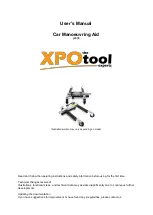Lexicon
300 V 3.0 Owner's Manual
3-24
Page Three
Machine Configuration
Mach Conf:
Dual-Mono
I : ANALOG
O : ANA+DIG
Page Four
Digital Interface and
Sampling Rates
Inp: * * * * *
Clk : 48kHz
Out: AES
Din : XLR
This upper line of this page describes the current format being input to the 300.
When no digital signal is present, the display will show "* * * * *" as above.
If the incoming audio signal is analog, selecting "Clk" allows Soft knob selection
of the system sample rate for analog operation: 48kHz or 44.1kHz. (The
appropriate sample rate LEDs on the left side of the display will illuminate to
indicate the sample rate selected.) If the input is digital, the system will
automatically lock to the sample rate of the incoming data and display "Lock."
Otherwise, "***" will be displayed to indicate that the incoming digital signal has
not yet been detected.
Either of the two left buttons on the botton allow selection of AES or SPDIF as
output format.
The two right buttons on the bottom row allow you to specify the connector used
for audio input: XLR, RCA, or OPT.
The upper line of this page describes the current machine configuration (Single,
Dual Mono or Cascade). The information that appears here is determined by the
type of Setup currently running.
Either of the two left buttons on the botton allow selection of Input: ANALOG and
DIGITAL are available as choices with all types of setups. A>L D>R (Analog/
Left, Digital/Right), or D>L A>R (Digital/Left, Analog/Right) is available for
selection in Dual Mono setups..
The two right buttons on the bottom row allow selection of Output: ANA+DIG is
available in all setup types. A(D Pre), or A(D Pst) and D(A Pre), or D(A Pst) are
available in Dual Mono setups. Cascade setups display choice between A(D
Pre, Mid or Pst) and D(A Pre, Mid or Pst) for patch point selection.
Summary of Contents for 300
Page 1: ...300 Digital Effects System V 3 0 Owner s Manual ...
Page 6: ......
Page 9: ......
Page 10: ...1 1 Installing the 300 1 Installing the 300 ...
Page 21: ...2 1 System Overview 2 System Overview ...
Page 30: ...3 1 System Operation 3 System Operation ...
Page 57: ...4 1 The Algorithms and their Parameters 4 The Algorithms and their Parameters ...
Page 93: ...5 1 The Presets 5 The Presets ...
Page 129: ...6 1 Time Code Operation 6 Time Code Operation ...
Page 139: ...7 1 MIDI Operation 7 MIDI Operation ...
Page 147: ...8 1 Troubleshooting 8 Troubleshooting ...


















